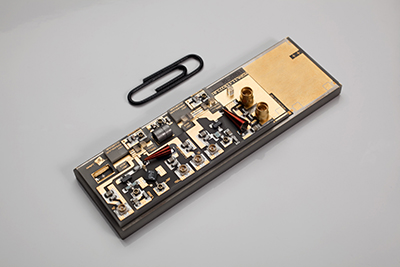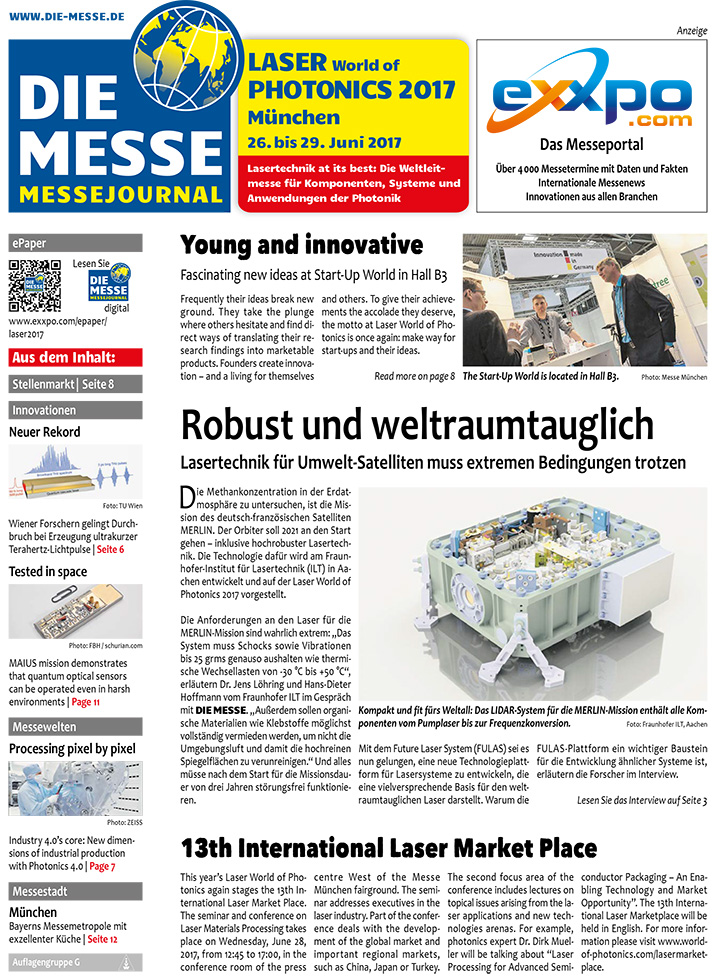16 June 2017
According to Albert Einstein’s Equivalence Principle, all bodies are accelerated at the same rate by the Earth’s gravity, regardless of their properties. Under conditions of microgravity, very long and precise measurements can be carried out to determine whether different types of atoms actually “fall equally fast” in the gravitational field of the Earth.
As part of a national consortium, Ferdinand-Braun-Institut, Leibniz-Institut für Höchstfrequenztechnik (FBH) and Humboldt-Universität zu Berlin (HU) now made a historical step towards testing the Equivalence Principle in the microcosm of quantum objects. In the MAIUS mission launched on 23 January 2017 a cloud of nano-Kelvin cold rubidium atoms has been generated in space for the first time ever. This cloud was cooled down with laser light and radio frequency electrical fields so that the atoms finally formed a single quantum object, a Bose-Einstein condensate (BEC).
Today’s quantum optical sensor is as small as a freezer and remains fully operational even after experiencing huge mechanical and thermal stress caused by the rocket launch. This groundbreaking mission is a pathfinder for applications of quantum sensors in space. In the future, scientists expect to use quantum sensor technology to cope with one of the biggest challenges of modern physics: the unification of gravitation with the other fundamental interactions (strong, weak, and electro-magnetic force) in a single consistent theory.
Laser modules for space applications
For this mission, the FBH has developed hybrid micro-integrated semiconductor laser modules that are suitable for application in space. These laser modules, together with optical and spectroscopic units provided by third partners, have been integrated and qualified by HU to provide the laser subsystem of the scientific payload. The results of this mission coordinated by Leibniz Universität Hannover do not only prove that quantum optical experiments with ultra-cold atoms are possible in space, but also give FBH and HU the opportunity to test their miniaturized laser system technology under real operating conditions.
The MAIUS mission is supported by the German Space Agency (DLR) with funds provided by the Federal Ministry of Economic Affairs and Energy and tests all key technologies of a space-borne quantum optical sensor on a sounding rocket: vacuum chamber, laser system, electronics, and software. The compact and robust diode laser system for laser cooling and atom interferometry with ultra-cold rubidium atoms has been developed under the leadership of the Optical Metrology Group at HU. This system is required for the operation of the MAIUS experiment and consists of four diode laser modules that have been developed by FBH as hybrid-integrated master-oscillator power-amplifier (MOPA) laser modules. The master laser is a monolithic distributed feedback (DFB) laser which is frequency-stabilized to the frequency of an optical transition in rubidium.
Quantum optical sensor tested in space
For the first time ever, a cloud of ultra-cold atoms has been successfully created in space on board of a sounding rocket. The MAIUS mission demonstrates that quantum optical sensors can be operated even in harsh environments like space – a prerequisite for finding answers to challenging questions of fundamental physics.
 Photo: FBH / schurian.com Photo: FBH / schurian.comHybrid-integrated master-oscillator power-amplifier (MOPA) laser module for rubidium precision spectroscopy in space |
As part of a national consortium, Ferdinand-Braun-Institut, Leibniz-Institut für Höchstfrequenztechnik (FBH) and Humboldt-Universität zu Berlin (HU) now made a historical step towards testing the Equivalence Principle in the microcosm of quantum objects. In the MAIUS mission launched on 23 January 2017 a cloud of nano-Kelvin cold rubidium atoms has been generated in space for the first time ever. This cloud was cooled down with laser light and radio frequency electrical fields so that the atoms finally formed a single quantum object, a Bose-Einstein condensate (BEC).
Today’s quantum optical sensor is as small as a freezer and remains fully operational even after experiencing huge mechanical and thermal stress caused by the rocket launch. This groundbreaking mission is a pathfinder for applications of quantum sensors in space. In the future, scientists expect to use quantum sensor technology to cope with one of the biggest challenges of modern physics: the unification of gravitation with the other fundamental interactions (strong, weak, and electro-magnetic force) in a single consistent theory.
Laser modules for space applications
For this mission, the FBH has developed hybrid micro-integrated semiconductor laser modules that are suitable for application in space. These laser modules, together with optical and spectroscopic units provided by third partners, have been integrated and qualified by HU to provide the laser subsystem of the scientific payload. The results of this mission coordinated by Leibniz Universität Hannover do not only prove that quantum optical experiments with ultra-cold atoms are possible in space, but also give FBH and HU the opportunity to test their miniaturized laser system technology under real operating conditions.
The MAIUS mission is supported by the German Space Agency (DLR) with funds provided by the Federal Ministry of Economic Affairs and Energy and tests all key technologies of a space-borne quantum optical sensor on a sounding rocket: vacuum chamber, laser system, electronics, and software. The compact and robust diode laser system for laser cooling and atom interferometry with ultra-cold rubidium atoms has been developed under the leadership of the Optical Metrology Group at HU. This system is required for the operation of the MAIUS experiment and consists of four diode laser modules that have been developed by FBH as hybrid-integrated master-oscillator power-amplifier (MOPA) laser modules. The master laser is a monolithic distributed feedback (DFB) laser which is frequency-stabilized to the frequency of an optical transition in rubidium.
More news about "Laser World of Photonics":
30 June 2017
Laser World of Photonics 2017: new record figures
Munich's photonics trade fair continues to grow: 1,293 exhibitors presented their products to the more than 32,000 trade visitors — "record figures for the trade fair on both counts", organizer Messe München reports. 800 of the 1,293 exhibitors were from abroad. 60 percent of the visitors and Congress participants traveled from outside Germany. (more…)24 June 2025
Acoustic emissions expose whether a laser process runs steadily or drifts off course. Fraunhofer IWS develops acoustic monitoring systems that evaluate laser machining directly and instantly. The goal: robust, economical process control to interpret sound emissions in real time and detect deviations immediately. The Dresden Institute showcases a market-ready module at Laser World of Photonics while expanding the approach to laser welding and cutting applications. (more…)21 March 2017
Laser technology in digital production
During the trade fair LASER World of PHOTONICS in Munich from June 26-29, 2017, leading manufacturers and research institutes will present tailor-made solutions for tomorrow's networked and highly automated world of production. (more…)13 November 2016
Photonics in the medical progress
The trade fair LASER World of PHOTONICS, from June 26 to 29, 2017 in Munich is awaiting more than 1,250 exhibitors to present visitors their ideas for the future of optical technologies. (more…)
| FAIR NAVIGATOR | |
|---|---|
|
| E-PAPER LASER WORLD OF PHOTONICS |
 |
